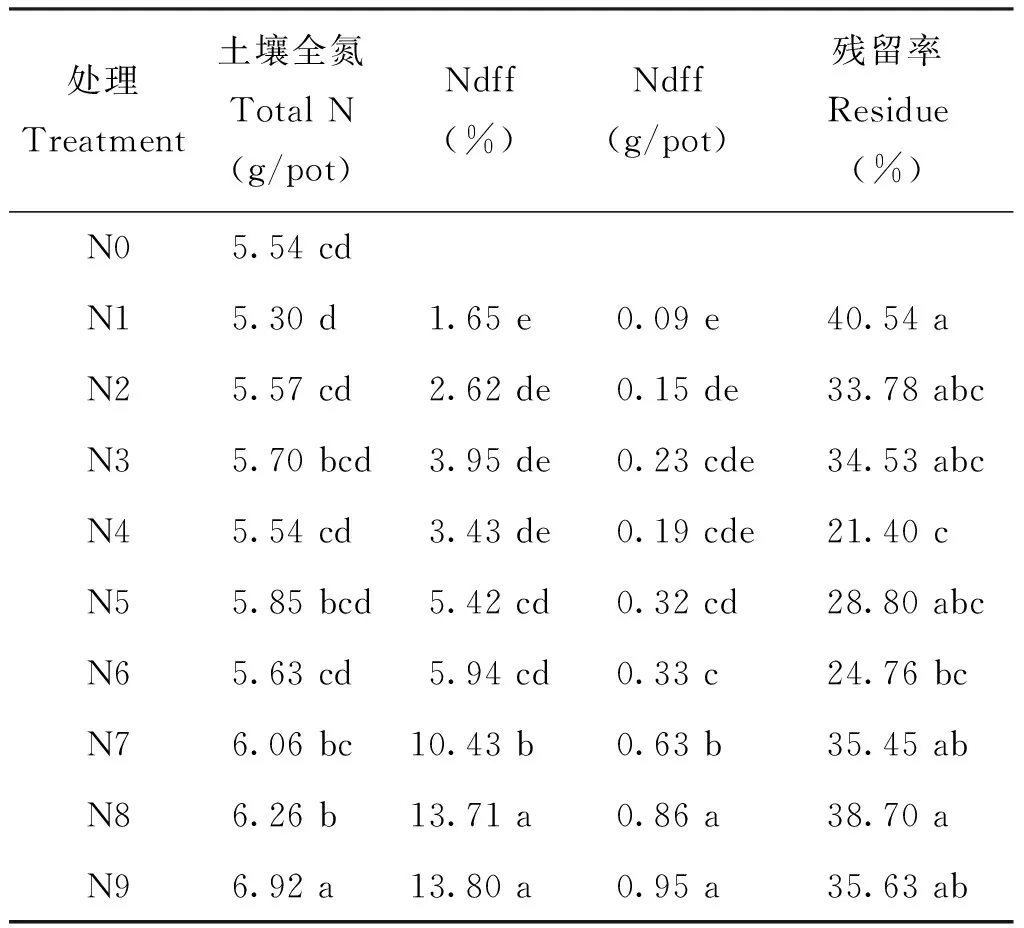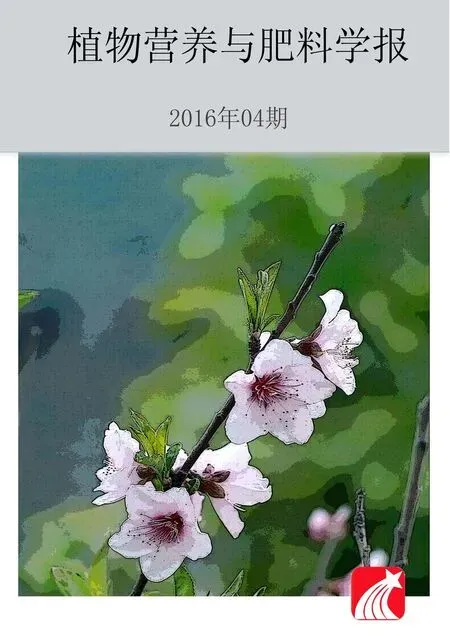用15N肥料标记法研究潮土中玉米氮肥的利用率与去向
山 楠, 杜连凤, 毕晓庆, 安志装, 赵丽平, 赵同科*
(1 中国农业大学资源与环境学院, 北京 100193; 2 北京市农林科学院植物营养与资源研究所, 北京 100097)
用15N肥料标记法研究潮土中玉米氮肥的利用率与去向
山 楠1, 2, 杜连凤2, 毕晓庆2, 安志装2, 赵丽平2, 赵同科2*
(1 中国农业大学资源与环境学院, 北京 100193; 2 北京市农林科学院植物营养与资源研究所, 北京 100097)

玉米;15N; 氮肥利用率; 盆栽培养

1 材料与方法
1.1试验点概况

1.2试验设计

1.3样品测定方法
玉米收获后取样,植株样烘干后称重,粉碎后测定15N同位素含量; 土壤样品风干后磨细,过0.15 mm筛,用于测定15N同位素。玉米植株和土样15N含量测定(质谱法)在河北省农林科学院遗传生理研究所用改进型ZHT-03质谱计(北京分析仪器厂)测定,测量精度0.1%。
1.4数据统计分析
氮素利用率主要计算方法[16]:
土壤全氮中来自标记15N肥料氮的百分数(Ndff, %)=土壤全氮的15N原子百分超/标记15N肥料原子百分超×100;
土壤全氮中来自15N肥料的氮量 (Ndff, g/pot)=土壤全氮含量(g/pot)×土壤全氮中来自肥料的百分数(%Ndff);
土壤中氮肥残留率(%)=土壤全氮中来自15N肥料的氮量(g/pot)/氮肥用量(g/pot)×100;
植株全氮中来自标记15N肥料氮的百分数(Ndff, %)=植株中15N肥料原子百分超/标记的15N肥料原子百分超×100;
植株全氮中来自15N肥料氮量 (Ndff, g/pot)=植物吸收的全氮含量(g/pot)×植物全氮中来自肥料的百分数(%Ndff);
肥料氮素回收率(%)=植物对15N肥料吸收的氮量(g/pot)/15N肥料施用量(g/pot)×100;
氮素总损失率(%)=(1-植株对氮肥回收率-土壤中氮肥残留率)×100;
肥料氮素损失量(g/pot)=氮肥用量(g/pot) ×氮素总损失率(%)。
试验数据采用Excel 2003和SPSS 17.0进行统计分析。
2 结果与分析
2.1玉米对氮素的吸收利用


表1 不同N肥水平下玉米植株地上部对肥料15N的吸收
注(Note): Ndff—肥料氮Nitrogen derived from fertilizer; Ndfs—土壤氮Nitrogen derived from soil; 同列不同小写字母表示处理间差异显著(P<0.05)Different small letters in the same column mean significant difference at 0.05 level among treatments.

2.2土壤氮素残留规律


表2 不同氮肥水平下肥料15N在土壤中残留
注(Note): Ndff—肥料氮Nitrogen derived from fertilizer; 同列数据后不同小写字母表示处理间差异显著(P<0.05)Values followed by different small letters in the same column are significantly different at 0.05 level among treatments.
2.3氮素损失状况

3 讨论
3.1玉米对氮肥的吸收利用特性

注(Note): 同列数据后不同小写字母表示处理间差异显著(P<0.05)Values followed by different small letters in the same column are significantly different at 0.05 level among treatments.
3.2玉米季的氮肥损失途径

4 结论

由此可见,氮素供应不足严重影响作物产量和氮肥的利用率。然而氮肥施用过量,不仅没有提高作物植株地上部生物量,反而造成氮肥的严重损失,降低氮肥利用率。该试验综合得出,N4处理,施肥量为N 88 mg/kg,作物对标记氮肥的吸收率为67.57%,标记氮肥土壤残留率为21.40%,标记氮肥损失率为11.04%,是较为科学合理的施肥量。
[1]国家统计局.中国统计年鉴2012[M].北京: 中国统计出版社, 2012.
National Bureau of Statistics of the People's Republic of China. China statistical yearbook 2012[M]. Beijing: China Statistics Press, 2012.
[2]Galloway J N, Dentener F J, Capone D G, et al. Nitrogen cycles: past, present, and future[J]. Biogeochemistry, 2004, 70(2): 153-226.
[3]朱兆良, 文启孝. 中国土壤氮素[M]. 南京: 江苏科技出版社, 1992. 213-249, 171-196.
Zhu Z L, Wen Q X. Soil nitrogen of China[M]. Nanjing: Jiangsu Science and Technology Press, 1992. 213-249, 171-196.
[4]张维理, 田哲旭, 张宁,李晓齐. 我国北方农用氮肥造成地下水硝酸盐污染的调查[J]. 植物营养与肥料学报, 1995, 1(2): 80-87.
Zhang W L, Tian Z X, Zhang N, Li X Q. Investigation of nitrate pollution in ground water due to nitrogen fertilization in agriculture in North China[J]. Plant Nutrition and Fertilizer Science,1995, 1(2): 80-87.
[5]吕殿青, 同延安, 孙本华, Ove Emteryd. 氮肥施用对环境污染影响的研究[J]. 植物营养与肥料学报, 1998, 4(1): 8-15.
Lü D Q, Dong Y A, Sun B H, Ove Emteryd. Study on effect of nitrogen fertilizer use on environment pollution[J]. Plant Nutrition and Fertilizer Science, 1998, 4(1): 8-15.
[6]蔡贵信, 朱兆良, 文启孝. 氨挥发[A]. 朱兆良, 文启孝. 中国土壤氮素[M]. 南京: 江苏科技出版社, 1992.
Cai G X, Zhu Z L, Wen Q X. Ammonia volatilization[A]. Zhu Z L, Wen Q X. Nitrogen status in soils of China[M]. Nanjing: Jiangsu Science and Technology Press, 1992.
[7]Xing G X. N2O emission from cropland in China[J]. Nutrient Cycling in Agroecosystems. 1998, 52(2-3): 249-254.
[8]Fageria N K, Baligar V C. Enhancing nitrogen use efficiency in crop plants[J]. Advance in Agronomy, 2005, 88: 97-185.
[9]王激清. 我国主要粮食作物施肥增产效应和养分利用效率的分析与评价[D]. 北京: 中国农业大学博士学位论文, 2007.
Wang J Q. Analysis and evaluation of yield increase of fertilization and nutrient utilization efficiency for major cereal crops in China[D]. Beijing: PhD Dissertation of China Agricultural University, 2007.
[10]赵久然, 郭强, 郭景伦, 等. 北京郊区粮田化肥投入和产量现状的调查分析[J]. 北京农业科学, 1997, 15(2): 36-38.
Zhao J R, Guo Q, Guo J L,etal. Investigation and analysis of input of chemical fertilizer and yield actuality in outskirt of Beijing[J]. Beijing Agricultural Science, 1997, 15(2): 36-38.
[11]周顺利. 高产条件下冬小麦、 夏玉米氮营养特性的基因型差异及氮肥推荐[D]. 北京: 中国农业大学博士学位论文, 2005.
Zhou S L. Response characteristics and fertilizer recommendation of different genotypic winter wheat and summer maize to nitrogen under high-yield condition [D]. Beijing: PhD Dissertation of China Agricultural University, 2000.
[12]吴永成, 周顺利, 王志敏, 罗延庆. 华北地区夏玉米土壤硝态氮的时空动态与残留[J]. 生态学报, 2005, 25(7): 1620-1625.
Wu Y C, Zhou S L, Wang Z M, Luo Y Q. Dynamics and residue of soil nitrate in summer maize in the North China Plain[J]. Acta Ecologica Sinica, 2005, 25 (7): 1620-1625.
[13]赵营, 同延安, 赵护兵. 不同施氮量对夏玉米产量、 氮肥利用率及氮平衡的影响[J]. 土壤肥料, 2006(2): 30-33.
Zhao Y,Tong Y A,Zhao H B. Effect of different N rates on yield of summer maize, fertilizer N recovery and N balance[J]. Soil and Fertilizer, 2006(2): 30-33.
[14]李志勇, 王璞, 魏亚萍, Boening-Zilkens M. 不同施肥条件下夏玉米的干物质积累、 产量及氮肥利用效率[J]. 华北农学报, 2003,18(4): 91-94.
Li Z Y, Wang P, Wei Y P, Boening-Zilkens M. Effects of different nitrogen fertilization managements on dry matter accumulation,yield and nitrogen use efficiency of summer maize[J]. Acta Agriculturae Boreali-Sinica, 2003, 18(4): 91-94.
[15]巨晓棠, 张福锁. 关于氮肥利用率的思考[J]. 生态环境, 2003, 12(2):192-197.
Ju X T, Zhang F S. Thinking about nitrogen recovery rate[J]. Ecology and Environment, 2003, 12(2): 192-197.
[16]巨晓棠, 刘学军, 邹国元, 等. 冬小麦/夏玉米轮作体系中氮素的损失途径分析[J]. 中国农业科学, 2002, 35(2): 1493-1499.
Ju X T, Liu X, Zou G Y,etal. Evaluation of nitrogen loss way in winter wheat and summer maize rotation system[J]. Scientia Agricultura Sinica, 2002, 35(2): 1493-1499.
[17]朱兆良.中国土壤氮素研究[J]. 土壤学报, 2008, 45(5): 778-783.
Zhu Z L. Research on soil nitrogen in China[J]. Acta Pedologica Sinica, 2008, 45(5): 778-783.
[18]丁洪, 王跃思, 李卫华. 玉米-潮土系统中不同氮肥品种的反硝化损失与N2O排放量[J]. 中国农业科学, 2004, 37(12): 1886-1891.
Ding H, Wang Y S, Li W H. Denitrification losses and N2O emission from different nitrogen fertilizers applied to maize-fluvo-aquic soil system[J]. Scientia Agricultura Sinica, 2004, 37(12): 1886-1891.
[19]巨晓棠, 潘家荣, 刘学军, 张福锁. 北京郊区冬小麦/夏玉米轮作体系中氮肥去向研究[J]. 植物营养与肥料学报, 2003, 9(3): 264-270.
Ju X T, Pan J R, Liu X J, Zhang F S. Study on the fate of nitrogen fertilizer in winter wheat/summer maize rotation system in Beijing suburban[J]. Plant Nutrition and Fertilizer Science, 2003, 9(3): 264-270.
[20]杜红霞, 吴普特, 冯浩, 等. 氮施用量对夏玉米土壤水氮动态及水肥利用效率的影响[J]. 中国水土保持科学, 2009, 7(4): 82-87.
Du H X, Wu P T, Feng H,etal. Influence of nitrogen application on soil moisture-nitrogen dynamics and water-fertilizer use efficiency ofZeamays[J]. Science of Soil and Water Conservation, 2009, 7(4): 82-87.
[21]范亚宁, 李世清, 李生秀. 半湿润地区农田夏玉米氮肥利用率及土壤硝态氮动态化[J]. 应用生态学报, 2008, 19(4): 799-806.

[22]易镇邪, 王璞. 包膜复合肥对夏玉米产量、 氮肥利用率与土壤速效氮的影响[J]. 植物营养与肥料学报, 2007, 13(2): 242-247.
Yi Z X, Wang P. Effect of coated compound fertilizer on yield, nitrogen use efficiency and soil available nitrogen in summer maize[J]. Plant Nutrition and Fertilizer Science, 2007, 13(2): 242-247.
[23]吕丽华, 陶洪斌, 王璞 等. 施氮量对夏玉米碳、 氮代谢和氮利用效率的影响[J]. 植物营养与肥料学报, 2008, 14(4): 630-637.
Lü L H, Tao H B, Wang P,etal. The effect of nitrogen application rate on carbon and nitrogen metabolism and nitrogen use efficiency of summer maize[J]. Plant Nutrition and Fertilizer Science, 2008, 14(4): 630-637.
[24]吴永成, 王志敏, 周顺利.15N 标记和土柱模拟的夏玉米氮肥利用特性研究[J]. 中国农业科学, 2011, 44(12): 2446-2453.
Wu Y C, Wang Z M, Zhou S L. Studies on the characteristics of nitrogen fertilizer utilization in summer maize based on techniques of soil column and15N-label[J]. Scientia Agricultura Sinica, 2011, 44(12): 2446-2453.
[25]李伟波, 李运东. 用15N 研究吉林黑土春玉米对氮肥的吸收利用[J]. 土壤学报, 2001, 38(4): 476-482.
Li W B, Li Y D. Application and recovery of15N-fertilizer for spring maize in black soil of Jilin[J]. Acta Pedologica Sinica, 2001, 38(4): 476-482.
[26]丁洪, 蔡贵信, 王跃思, 等. 玉米-小麦轮作系统中氮肥反硝化损失与 N2O排放量[J]. 农业环境科学学报, 2004, 22(5): 557-560.
Ding H, Cai G X, Wang Y S,etal. Nitrification-denitrification loss and N2O emission from maize-wheat rotation system in North China[J]. Journal of Agro-Environment Science, 2003, 22(5): 557-560.
[27]苏芳, 丁新泉, 高志岭, 等. 华北平原冬小麦-夏玉米轮作体系氮肥的氨挥发[J]. 中国环境科学, 2007, 27(3): 409-413.
Su F, Ding X Q, Gao Z L,etal. Ammonia volatilization from nitrogen fertilization in winter wheat-summer maize rotation system in the North China plain[J]. China Environmental Science, 2007, 27(3): 409-413.
[28]山楠, 赵同科, 毕晓庆, 等. 不同施氮水平下小麦田氨挥发规律研究[J]. 农业环境科学学报,2014,33(9): 1858-1865.
Shan N, Zhao T K, Bi X Q,etal. Ammonia volatilization from wheat soil under different nitrogen rates[J]. Journal of Agro-Environment Science, 2014,33(9): 1858-1865.
[29]巨晓棠, 刘学军, 张福锁. 不同氮肥施用后土壤各氮库的动态研究[J]. 中国生态农业学报, 2004, 12(1): 92-94.
Ju X T, Liu X J, Zhang F S. Dynamics of different soil nitrogen pools after applying different types of nitrogen fertilizers[J]. Chinese Journal of Eco-Agriculture, 2004, 12(1): 92-94.
Nitrogen use efficiency and behavior studied with15N labeled fertilizer in maize in fluvo-aquic soils
SHAN Nan1,2, DU Lian-feng2, BI Xiao-qing2, AN Zhi-zhuang2, ZHAO Li-ping2, ZHAO Tong-ke2*
(1CollegeofResourcesandEnvironmentalSciences,ChinaAgriculturalUniversity,Beijing100193,China; 2InstituteofPlantNutritionandResources,BeijingAcademyofAgricultureandForestrySciences,Beijing100097,China)
【Objectives】 In this study, an experiment was conducted for quantitative characteristics of nitrogen (N) fertilizer utilization and the fate of fertilizer N on “N uptake-soil residues-loss” in summer maize in Beijing Academy of Agriculture and Forestry in 2013. 【Methods】 A pot experiment was carried out using15N-label method inside an artificial weather shed. Ten N fertilizer application rates were designed with three replicates: 0, 22, 44, 66, 88, 111, 133, 177, 222 and 266 mg/kg. The characteristics and nitrogen utilization of soil and maize plant were measured.【Results】 With the increase of N fertilizer applied, there was no significant difference in N fertilizer use efficiency, but showed a tendency of rising firstly and then falling. Agronomic efficiency of applied N-fertilizer and apparent N fertilizer recovery efficiency decreased significantly. The recovery ratio of15N was 9.01%-67.57% in maize season and the percentage of residual15N in soil was 21.40%-40.54%. Residual15N rates of different soil layers increased significantly with the increase of N fertilizer applied and decreased notably. Loss rates of15N increased significantly with the increase of N fertilizer applied and total15N loss ratio was 11.04%-50.45%. Compared with N 22, 44 and 66 mg/kg treatments, the soil N accumulation was reduced by 19.14%, 12.38% and 13.13% in N 88 mg/kg treatment, respectively. Moreover, the N loss rate was reduced by 39.41%, 7.88% and 13.88%, respectively. Compared with N 111, 133, 177, 222 and 266 mg/kg treatments, the plant N accumulation was increased by 5.88%-8.00% and the N recovery rate was increased by 9.06%-27.81% in N 88 mg/kg treatment. In the other hand, the soil N accumulation was reduced by 3.36%-17.30%, and the N loss rate during the maize growing period was reduced by 1.65%-13.57%.【Conclusions】 Under the condition of this experiment, proper rate of N applied in maize was recommended at 88 mg/kg, and N use efficiency was the highest with 67.57%, and the percentage of residual N and loss rate of N were the least with 21.40% and 11.04%, presenting less pressure to the environment.
maize;15N-label technique; nitrogen fertilizer utilization; pot experiment
2015-02-16接受日期: 2015-05-15
国家科技支撑计划项目(2012BAD15B01)资助。
山楠(1988—), 女, 河北唐山人, 博士研究生, 主要从事农业环境方面的研究。 E-mail: sn.47@163.com
Tel: 010-51503584, E-mail: tkzhao@126.com
S143.1+4; S513.62
A
1008-505X(2016)04-0930-07

